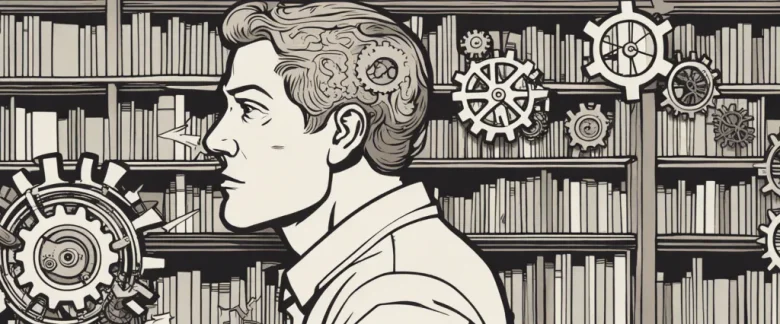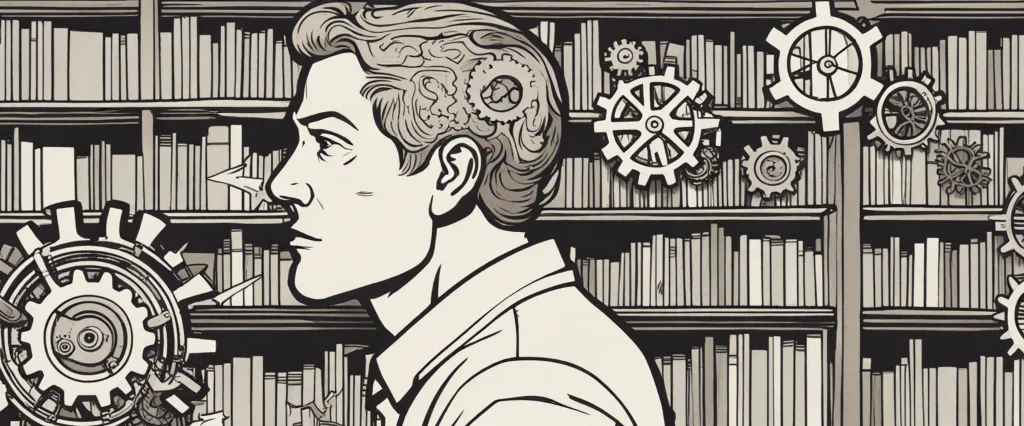In “The Man Who Couldn’t Stop,” David Adam takes readers on a captivating exploration of the mind’s mysterious tendencies towards obsession and the debilitating impact it can have on one’s life. Drawing from his personal experiences as someone who lives with obsessive-compulsive disorder (OCD), Adam offers a unique and intimate perspective on this perplexing condition. As an award-winning science writer and journalist, David Adam has become renowned for his ability to unravel complex subjects, making them accessible to a wide audience. Through his eloquent storytelling and extensive research, Adam not only provides invaluable insight into the complexities of OCD, but also sparks thought-provoking discussions on our understanding of mental health.
Chapter 1: Introduction to OCD
Chapter 1 of The Man Who Couldn’t Stop by David Adam introduces the reader to the topic of Obsessive-Compulsive Disorder (OCD). The chapter begins with the author recounting his personal experiences with OCD, sharing his own struggle with intrusive thoughts and the unrelenting need to perform rituals or compulsions to alleviate his anxiety. Adam provides vivid examples of his obsessions, such as the fear of contaminating others with HIV and the constant counting of stairs. These experiences help the reader understand the overwhelming nature of OCD and its impact on day-to-day life.
To explain the disorder, Adam delves into the historical background and development of our understanding of OCD. He discusses how the condition has been observed throughout various cultures and time periods, even though the term “OCD” itself is relatively new. He explores early historical references and theories about the disorder, including the belief that OCD was a result of possession by demons or moral or religious weakness. Adam illustrates how our understanding of the disorder has evolved over time, from Freud’s psychoanalytic approach to the identification of common obsessions and compulsions.
Furthermore, the chapter provides an overview of the biological underpinnings of OCD. Adam discusses the involvement of specific brain regions and the role of neurotransmitters like serotonin in the development and maintenance of the disorder. He explains how abnormalities in these brain mechanisms can lead to obsessions and compulsions.
Overall, Chapter 1 sets the stage for the subsequent exploration of OCD by introducing the personal experiences of the author and providing a historical and biological context for the disorder. It establishes the diverse and complex nature of OCD, leaving the reader eager to learn more about this mysterious condition.
Chapter 2: The Nature of Obsessions
Chapter 2: The Nature of Obsessions of The Man Who Couldn’t Stop by David Adam explores the intricate and often overwhelming world of obsessive-compulsive disorder (OCD). The author himself, sharing his personal experience with the disorder, delves into the nature of obsessions that plague those suffering from OCD.
Adam begins by explaining the difference between regular worrying or intrusive thoughts and obsessions. While occasional worries are common, obsessions are incessant, recurring, and typically irrational thoughts that create immense anxiety. He emphasizes that the intensity of obsessive thoughts is what distinguishes OCD from casual worrying.
The chapter goes on to illustrate various types of obsessions experienced by individuals with OCD. These obsessions can range from germs and cleanliness to symmetry, order, or even blasphemous or violent thoughts. The author shares his own obsession with AIDS and HIV, constantly fearing that he had caught the disease despite very minimal risk.
Adam highlights the vicious cycle that OCD perpetuates. The more one tries to suppress or ignore the obsessive thoughts, the stronger they become. This leads to a compulsive urge to perform rituals or behaviors, called compulsions or rituals, to temporarily alleviate the anxiety.
The chapter also discusses the impact of obsessions on daily life, relationships, and overall mental health. Adam describes how obsessions can consume one’s thoughts and time, causing distress and affecting personal and professional life.
In summary, Chapter 2 explores the nature of obsessions in OCD, emphasizing their irrational and intrusive characteristics. It emphasizes the distressing impact obsessions have on the affected individuals and the perpetual cycle of anxiety and compulsion they create. Adam’s personal anecdotes provide a relatable viewpoint that helps readers empathize with the challenges faced by those living with OCD.
Chapter 3: The Compulsion Conundrum
Chapter 3 of “The Man Who Couldn’t Stop” by David Adam is titled “The Compulsion Conundrum.” In this chapter, Adam delves into the origins and nature of obsessions and compulsions, focusing particularly on his personal experience with obsessive-compulsive disorder (OCD).
Adam begins by discussing the distinct features of OCD, highlighting the intrusive thoughts and the subsequent rituals or compulsions sufferers engage in to alleviate anxiety. He explains how these thoughts and behaviors are not simply quirks or eccentricities but rather a consequence of a neurological glitch that manifests as a compulsion to seek certainty and control.
The author takes readers on a journey through various encounters with psychologists and therapists who try different therapeutic approaches to help him manage his OCD. He describes the challenges of finding the right kind of therapy and a therapist who understands the complexity of his condition. Adam also acknowledges the role of medication, discussing his experiences with different drugs and their effects on his symptoms.
Throughout the chapter, Adam explores the neurological and psychological mechanisms behind compulsions. He delves into research on the brain circuitry involved in OCD and the role of the neurotransmitter serotonin. He also highlights the various theories and paradigms that attempt to explain why certain individuals are more prone to obsessions and compulsions.
Ultimately, “The Compulsion Conundrum” provides readers with an in-depth understanding of the nature of OCD and its complexities. Adam’s personal experiences, combined with scientific explanations and theories, shed light on the challenges faced by individuals living with this disorder and the ongoing search for effective treatments.
Chapter 4: The Brain and OCD

Chapter 4 of “The Man Who Couldn’t Stop” by David Adam delves into the relationship between the brain and Obsessive-Compulsive Disorder (OCD). The author begins by introducing OCD as a mental disorder characterized by intrusive thoughts (obsessions) and repetitive behaviors (compulsions). He emphasizes that OCD is not simply a result of personality flaws, but rather a neurological condition rooted in the intricate workings of the brain.
Adam explores various regions of the brain associated with OCD, particularly the orbitofrontal cortex (OFC), which is responsible for decision-making and evaluating potential outcomes. In people with OCD, the OFC is deemed hyperactive and becomes fixated on negative possibilities, leading to obsessive thoughts. The basal ganglia, another brain region, plays a role in regulating movements, and when it malfunctions, it may contribute to the compulsive behaviors observed in OCD.
The author introduces the concept of “neural noise,” which suggests that during decision-making processes, random fluctuations in the brain’s signals can cause misinterpretation. These fluctuations can influence people with OCD, making them perceive potential threats in everyday situations. Moreover, people with OCD display reduced activity and connectivity between the frontal lobe and the deeper structures of the brain.
Adam also highlights the importance of serotonin in OCD. Serotonin is a neurotransmitter involved in regulating mood and anxiety. Lower levels of serotonin are associated with OCD symptoms, which is why selective serotonin reuptake inhibitors (SSRIs) are often prescribed as a treatment.
In summary, Chapter 4 explores the neurological underpinnings of OCD, emphasizing the involvement of brain regions like the orbitofrontal cortex and basal ganglia. The chapter also introduces the concepts of neural noise and serotonin to further understand the mechanisms behind this debilitating disorder.
Chapter 5: Treatment Approaches
Chapter 5: Treatment Approaches of the book “The Man Who Couldn’t Stop” by David Adam explores various methods and approaches used to treat obsessive-compulsive disorder (OCD). The author shares his personal experiences with different treatments and interviews experts to provide insights into the effectiveness of these approaches.
The chapter begins by delving into the history of OCD treatment and the evolution of understanding this disorder. Adam describes how early treatments involved drastic measures such as frontal lobotomies or inducing epileptic seizures, but these approaches had severe side effects and questionable long-term outcomes.
The author then discusses the development of exposure therapy as a treatment for OCD. He interviews patients and experts who provide firsthand accounts of their experiences with this approach. Exposure therapy involves facing one’s fears and gradually exposing oneself to anxiety-triggering situations, helping individuals develop tolerance and eventually reduce their compulsions. Adam illustrates how exposure therapy can be uncomfortable and challenging, yet ultimately effective.
Next, he explores the use of medication for OCD treatment. Adam describes his own experiences with different medications and highlights the complexities of finding the right drug or combination that works for each individual. He explains how medication can help manage symptoms but is often not a cure, leading many to opt for a combination of medication and therapy.
The chapter concludes by discussing newer treatment methods like deep brain stimulation (DBS) and transcranial magnetic stimulation (TMS). Adam explores their potential in targeting specific brain regions associated with OCD symptoms, but acknowledges that these approaches are still in their early stages and more research is needed.
In summary, Chapter 5 of “The Man Who Couldn’t Stop” provides a comprehensive overview of various treatment approaches for OCD, including exposure therapy, medication, and emerging methods. Adam presents a balanced perspective by incorporating personal anecdotes, patient experiences, and expert opinions, shedding light on the complexities of finding effective treatments for this challenging disorder.
Chapter 6: Living with OCD
Chapter 6 of “The Man Who Couldn’t Stop” by David Adam explores the daily challenges of living with Obsessive-Compulsive Disorder (OCD). The chapter begins with Adam reflecting on his own journey with OCD and the impact it has had on his life. He explains that OCD is characterized by intrusive thoughts and compulsions – repetitive behaviors or mental acts that individuals feel compelled to perform.
Adam discusses the various ways OCD can manifest in an individual’s life, including contamination fears, hoarding, and the need for symmetry. He provides anecdotal examples of individuals he has encountered who struggle with these particular obsessions and compulsions. He explains how these manifestations of OCD can be time-consuming, distressing, and often interfere with everyday activities.
Furthermore, Adam delves into the concept of “just right” OCD, which is characterized by a strong need for order and symmetry. He explains how individuals with this subtype of OCD are obsessed with getting things “just right” and will repeat actions until they feel an inner sense of symmetry or completion. Adam draws from his own experiences, detailing the specific rituals he used to engage in, such as aligning objects and performing actions in a specific order.
The chapter also highlights the struggles and frustrations faced by individuals with OCD. The constant fight to suppress or control thoughts, the anxiety associated with uncertainty, and the fear of not being able to meet their own internally-imposed standards can be overwhelming. Adam emphasizes the importance of finding effective coping mechanisms, such as therapy and medication, to manage OCD and improve quality of life.
In summary, Chapter 6 of “The Man Who Couldn’t Stop” provides insight into the daily challenges faced by individuals living with OCD, exploring its various manifestations and the impact it can have on their lives.
Chapter 7: Stigma and Misunderstanding
Chapter 7 of “The Man Who Couldn’t Stop” by David Adam delves into the stigma and misunderstanding that surrounds obsessive-compulsive disorder (OCD). The chapter begins with the author sharing stories of individuals with OCD who have encountered hardships due to societal ignorance and judgment.
Adam emphasizes how OCD is often wrongly portrayed in media, where it is simplistically equated to a quirk or a desire for cleanliness. This leads to a lack of understanding and empathy towards those who suffer from the disorder. He highlights how this misunderstanding manifests in real-life situations, such as people being fired from their jobs or facing discrimination in relationships due to their perceived “odd” behaviors.
The chapter also explores how the history of OCD has contributed to its stigma. OCD was once attributed to demonic possession or treated as a joke, perpetuating negative stereotypes. Even today, the author shares his personal experience of feeling ashamed and hiding his own OCD symptoms, fearing the judgment and ridicule of others.
Adam discusses various efforts made by advocacy groups to eliminate this stigma, such as OCD Action’s campaign called “Pure,” which aimed to highlight OCD beyond the clichéd representation. He also describes how celebrities like David Beckham and Leonardo DiCaprio have come forward, speaking openly about their struggles with OCD, which helps educate the public and break down stereotypes.
In conclusion, Chapter 7 sheds light on the often misunderstood and stigmatized nature of OCD. It illustrates the consequences this stigma has on individuals with OCD and emphasizes the need for society to develop a more empathetic and accurate understanding of the disorder.

Chapter 8: Hope and Coping Strategies
Chapter 8 of “The Man Who Couldn’t Stop” by David Adam focuses on the topics of hope and coping strategies. The chapter delves into various ways in which individuals with obsessive-compulsive disorder (OCD) manage their condition and find hope amidst its challenges.
Adam explores the role of medication in OCD treatment, highlighting how selective serotonin reuptake inhibitors (SSRIs) can be helpful in reducing symptoms. However, he also acknowledges that these medications are not a one-size-fits-all solution. Each individual responds differently, and finding the right medication and dosage may require trial and error.
The author introduces cognitive-behavioral therapy (CBT) as another key approach to managing OCD. CBT helps individuals identify their negative thought patterns, challenge them, and develop healthier coping mechanisms. Adam interviews people who have undergone CBT and finds that it can be highly effective in enabling individuals to regain control over their obsessions and compulsions.
Additionally, the chapter explores alternative therapies and self-help strategies adopted by some OCD sufferers. These include mindfulness meditation, exercise, support groups, and creative outlets like art and music. Adam emphasizes that while these approaches may not be scientifically proven, they can still provide significant relief and hope to individuals battling OCD.
Overall, Chapter 8 explores the multifaceted nature of OCD treatment, recognizing that each person’s journey is unique. It highlights the importance of finding a combination of strategies that work best for each individual, whether it involves medication, therapy, alternative methods, or a combination of approaches. The chapter offers insights into the ongoing pursuit of hope and the search for effective coping strategies in the face of OCD.
After Reading
In conclusion, David Adam’s “The Man Who Couldn’t Stop” is a captivating exploration of obsessive-compulsive disorder (OCD) that delves deep into the author’s personal experiences and extensive research. Through a mix of science, history, and personal anecdotes, Adam sheds light on the complex nature of OCD, highlighting the fear, anxiety, and uncontrollable thoughts that plague individuals living with this condition. By sharing his own struggles and meeting fellow sufferers, Adam fosters a sense of empathy and understanding, ultimately challenging stigmas and misconceptions surrounding OCD. With its informative and engaging narrative, “The Man Who Couldn’t Stop” offers readers valuable insights into the mind of someone with OCD and encourages compassion for those wrestling with this often-misunderstood disorder.
1. Brain Storms: The Race to Unlock the Mysteries of Parkinson’s Disease by Jon Palfreman – This book delves into the world of Parkinson’s disease, exploring the scientific advancements and the personal stories of those affected by this neurodegenerative disorder.
2. The Tell-Tale Brain: A Neuroscientist’s Quest for What Makes Us Human by V.S. Ramachandran – Ramachandran takes readers on a captivating journey into the mysteries of the human brain, exploring the relationship between brain and behavior through fascinating case studies and experiments.
3. The Broken Mirror: Understanding and Treating Body Dysmorphic Disorder by Katharine A. Phillips – For those interested in exploring the complexities of obsessive-compulsive disorders, Phillips provides a comprehensive and insightful examination of body dysmorphic disorder, its impact on individuals, and potential treatment approaches.
4. My Age of Anxiety: Fear, Hope, Dread, and the Search for Peace of Mind by Scott Stossel – Stossel bravely shares his personal experiences with anxiety disorder and delves into the history and science of anxiety, providing readers with an insightful and empathetic perspective on the subject.
5. The Man Who Wasn’t There: Investigations into the Strange New Science of the Self by Anil Ananthaswamy – In this thought-provoking book, Ananthaswamy explores the nature of self and identity by investigating conditions such as anosognosia, phantom limb syndrome, and Cotard’s syndrome, shedding light on the complex relationship between the mind and self-perception.




